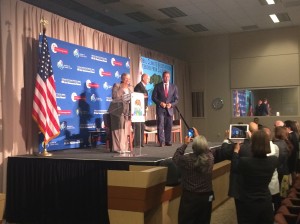This morning in Sacramento, former California Governor Arnold Schwarzenegger journeyed back to his old stomping ground to highlight the state’s successes fighting climate change. He joined current governor Jerry Brown and a host of climate experts and business leaders to make the case for the 2015 Paris climate talks that California’s example can be replicated at an international scale.
But for all the dignitaries, politicians, and experts, there was actually very little said about the specific policies that seem to work in California. Nor was there discussion of any of the clean tech businesses that are leading the way to reduce greenhouse gases. Instead, it was a largely symbolic, self-congratulatory event, sprinkled with some useful facts and motivational talks.
First up, the former governator ran through the history of California’s climate fight since he took office, talking about how big business fought the climate agenda at every turn, claiming doom and gloom and seeking to overturn AB 32, the climate law, with a 2010 ballot initiative. “But Californians terminated it” at the polls, he quipped, “saying ‘hasta la vista baby’ to the oil companies.’ Later, Governor Brown echoed this sentiment about big businesses always crying wolf about environmental regulations, noting that Henry Ford himself even came to California to lobby against fuel efficiency standards in the 1970s.
Climate scientists followed, including UC Berkeley’s Dam Kammen and the Pacific Institute’s Peter Gleick. Gleick brought home the impacts of climate change on California when he noted that $100 billion worth of 2000-era buildings are threatened by sea level rise, which could displace 480,000 people living on the coastline and jeopardizing 10,000 megawatts worth of power plants, among other calamities.
A business panel followed, although not one with any of the leading clean technology companies. Former EPA head and now Apple Computers Executive Lisa Jackson described the “fun” and “opportunities” of fighting climate change at Apple with their net-zero data centers. Michael Britt of UPS acknowledged that the company is not afraid of higher gas prices under AB 32 and described internal combustion engines as an unsustainable “bridge” to cleaner technologies. The company will deploy 17 fuel cell trucks in the coming months at one-third the maintenance costs of traditional engines.
State Senate President-to-be Kevin De Leon then joined a panel where he discussed his efforts to include low-income Californians in the fight against climate change. His one million constituents live in a district criss-crossed by seven major freeways, and with 40% of the goods in the United States shipped through there, “a little girl’s lungs subsidize” the cheap purchases we make. Moderator Terry Tamminen noted that kids near the port in Los Angeles/Long Beach lose one percent of their lung capacity on average each year. De Leon felt that government should encourage more private investment in clean technologies, because “there isn’t enough public money” to do the job. He specifically cited the need for a stronger state infrastructure bank, one of the few specific policy needs discussed today.
Finally the current governor spoke, bringing laughs when he said that California’s environmental fight began with a Republican actor turned governor — Ronald Reagan of course, not Schwarzenegger. Brown’s point was that under Reagan and President Nixon, California secured a waiver in the federal Clean Air Act to go beyond federal standards, paving the way for California’s continued leadership on environmental issues. Ultimately, Brown described how we need to look to scientists and entrepreneurs to save us, while government can provide them the incentives.
Missing in the discussion today was exactly that: the businesses and the incentives. For example, no mention of Tesla, the California-bred company that is probably doing the most right now to bring down the costs of the technologies needed to clean our economy. And only a brief mention of the solar rooftop incentives in California and cap-and-trade, with nothing about California’s landmark energy storage law.
If California is going to make a case to the world about the policies needed to reduce carbon, we’ll need to do a better job than what our leaders did today. We can certainly brag about the broad goals California has set, and we should do so. But unless we can demonstrate the specific business and health advantages that the California program has brought, it will all seem pie-and-the-sky to outsiders.
One thought on “Two Governors, One Vague Climate Change Program”
-
Pingback: California Legislation Watch: Weekly Update | Streetsblog Los Angeles
Leave a Reply
You must be logged in to post a comment.




